The age of the electric airplane has been much written about but far less demonstrated and delivered. So when Pipistrel Aircraft, the innovative Slovenian company, announced last April at Aero that it was ready to deliver a functional electric trainer, it drew crowds of the curious. But is the technology really ready for broad market distribution or does it remain a curiosity waiting for more mature technology?
Based on a recent trip to Pipistrel’s factory, where we examined the new Alpha Electro and flew it twice, we would say it’s somewhere between. Apart from its short flight legs—about an hour, give or take—the Electro is all but indistinguishable from its gasoline equivalent. It performs similarly, flies the same and even sounds somewhat similar from inside the cabin. It’s more expensive than the gasoline version, but Pipistrel expects that price to come down as batteries gain more capacity at lower cost and motor prices decrease with more competition from additional vendors.
Pipistrel estimated that the Electro would have about a 60-minute endurance with an additional half hour of reserve, but we didn’t see that in our trials. More like about an hour or so total with reserve enough to land safely for a recharge. Recognizing that it can’t do what a gasoline aircraft can, Pipistrel is pitching the Alpha Electro for one narrow purpose: as a dedicated takeoff and landing trainer in a school otherwise equipped with gasoline trainers. That the Electro can do this is inarguable. The unanswered question is can (or will) flight schools invest in such a narrowly contrived tool and can they make money in doing so? Early adopters are defined by a willingness to accept compromises that mainstream buyers will not and that seems to be where the Electro will find its initial market.
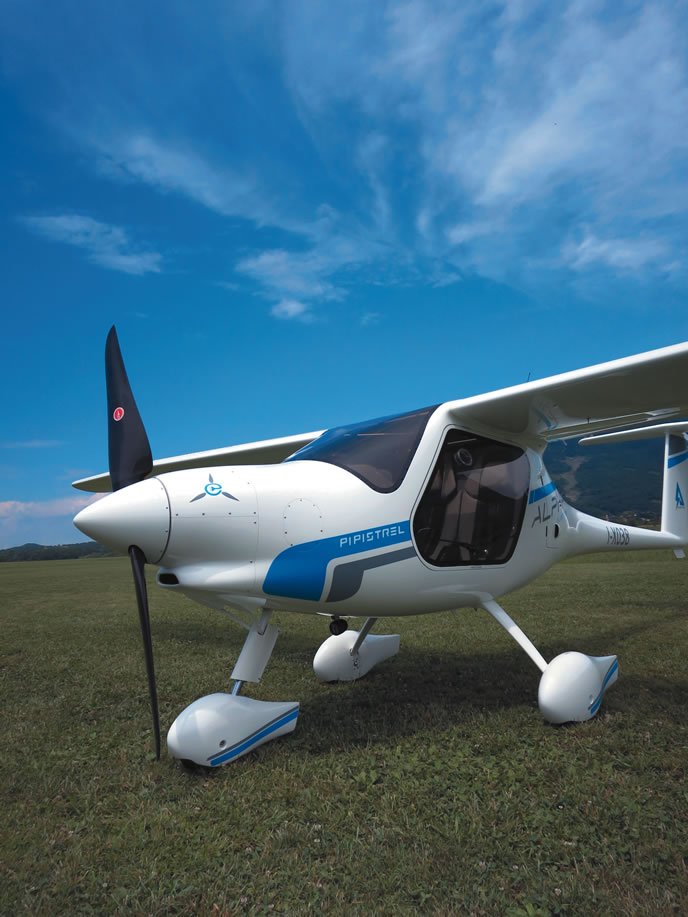
Conversion, Compromise
At the Electric Aircraft Symposium in Santa Rosa, California, last April, Pipistrel’s Tine Tomazic commented during a presentation on the Electro that he was glad it would be the last conversion the company would do. “Just because the airplane is electric,” Tomazic said, “it doesn’t mean it requires any less horsepower.” That’s another way of saying unless an airplane is feather light—and even then—current battery technology will sharply limit the flight duration of pure-electric aircraft.
That said, the Alpha airframe might be an ideal candidate for electric conversion. Its antecedents flow from the high-aspect ratio, low-drag sailplane airframes popular in this region of the world. Originally certified as a European microlight, the Alpha has, by U.S. standards, a low empty weight and a high enough useful load to nearly lift its own weight. (See our April 2015 review of the Alpha, which reports a useful load of 264 kg (581 pounds) on an empty weight of 287 kg or 631 pounds.) That means the Alpha airframe has sufficient, if not plenty of, capacity for batteries. And it needs a lot of them.
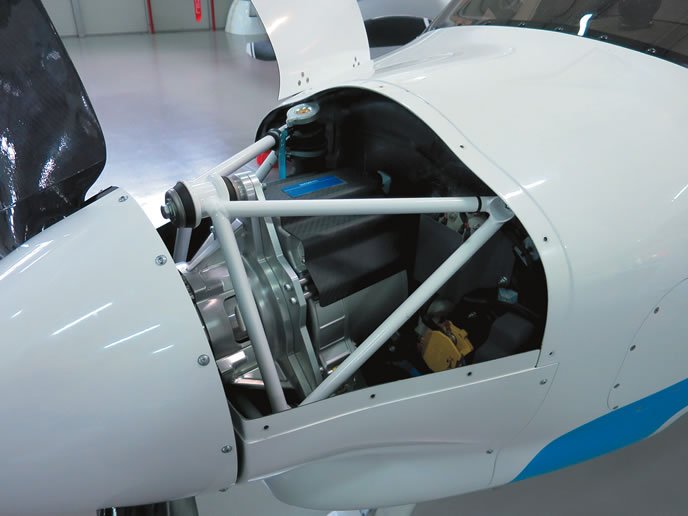
Conceptually, the Alpha Electro is simply an electric motor in place of an 80-HP Rotax 912 and batteries in place of fuel tanks. But the execution is far more complex than that and involves more electric and electronic engineering than the casual observer might expect.
First, the batteries. Pipistrel uses lithium-polymer chemistry which, allowing for the enclosures and management systems, yields about 155 wh/kg; typical energy density for lithium-ion systems these days. Total battery weight is 126 kg (277 pounds) divided evenly between a forward compartment behind the engine and a second identical compartment behind the cabin. The gasoline version has a small baggage compartment behind the two occupant seats, but the Electro loses that space to the batteries.
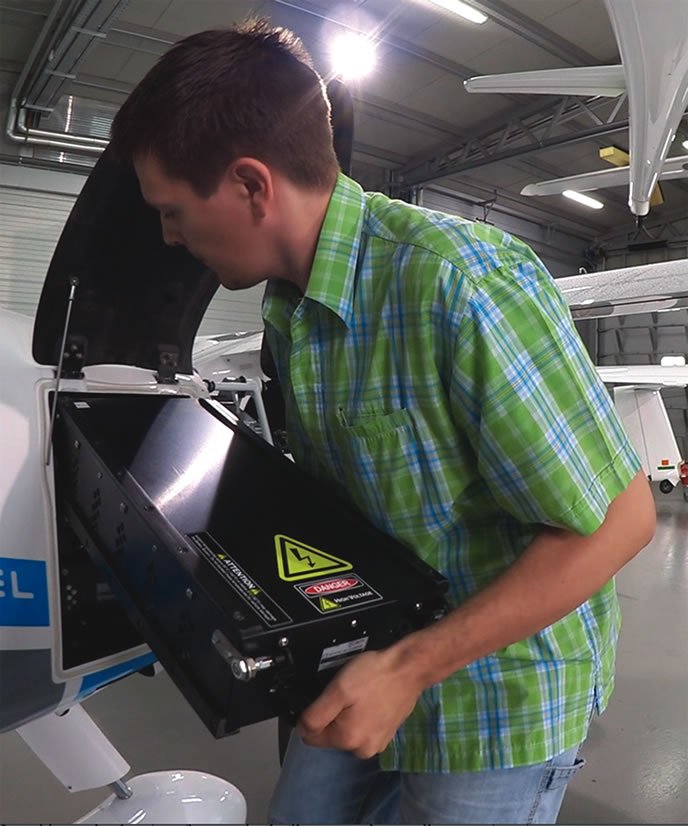
The batteries themselves are individual 3.7-volt (when charged)cells linked into what Pipistrel calls “logical cells” consisting of three individual cells. These logical cells are grouped together in a single, quick-change battery box containing 36 logical cells or 108 individual cells. There are six quick-change boxes, for a total of 648 cells. The airplane’s nominal system voltage is 324 to 453 and to achieve this, the individual cells are wired in parallel to form the logical cells and the logical cells in series so that each of the battery compartments produces 399 volts. The compartments are in turn connected in parallel to drive the motor.
If all of this sounds straightforward, it’s anything but simple. Each battery box has its own battery management system, which are in turn overseen by a central computer of Pipistrel’s own design, according to Crt Gorup, who wrote the computer’s code. To call this system sensor rich is an understatement. There are a dozen temperature sensors alone in each battery box, plus additional sensors for connectors to monitor heat buildup from high resistance and temperature sensors for the motor and inverter. There’s even coolant to keep track of.

That’s right, coolant. The brushless DC motor Siemens provided for the Electro is so power dense that its internal windings require cooling, which is done via a small pump circulating a glycol blend from a reservoir behind the motor. Does that mean that electric airplanes have radiators? The Alpha Electro does and it’s about the size of a Rotax oil cooler. It channels air through an inlet on the belly and yes, Pipistrel had to contend with cooling drag, even though high cruise speed is not the Electro’s forte.
Similarly surprising is that the motor is geared, not direct drive as we might have expected. The reason for this appears to be an artifact from the motor being developed for other than aircraft use. Pipistrel founder Ivo Boscarol declined to say what the application was, but we suspect it’s automotive. Boscarol said future iterations of the motor are likely to be direct drive, lighter and cheaper. “There will be more companies with motors.” Boscarol said. “There will have to be. Electric airplanes won’t be competitive with gasoline if the electric engines cost as much as the rest of the airplane.”
In the Electro, Pipistrel limits the electric engine to 60 kW or about 80 HP, the same as the gasoline Alpha. Even though the engine is capable of more output, Pipistrel wanted the airplane to perform exactly like the gasoline version and more power would guzzle the Electro’s limited battery capacity, stunting its endurance further.
Pipistrel has priced the Electro at about €100,000 or $113,000 at recent exchange rates. Battery replacement cycles are expected to be about 2000 hours at a price comparable to a Rotax overhaul. It’s unknown if the batteries will deliver this kind of service life, but Pipistrel’s testing suggests they will.

Charging, Endurance
At the EAS, Pipistrel’s Tomazic quipped that the Electro’s batteries were “600 little nightmares,” an inside joke that a battery-savvy audience that was about to sit through an NTSB review of Boeing 787 lithium-ion fires resonated with. But lithium-ion safety is no joke and everyone in the industry knows it. Although fires due to cell shorts and unbalanced charging are a worry, the exact numerical nature of the risk for aircraft remains undefined. Given what is known, Pipistrel says it has taken appropriate precautions. The cells are contained in carbon fiber thermally isolating housings that form the removable, quick-change boxes and because the airplane should never be more than a minute or two from a runway, these are intended to provide sufficient protection.
But Pipistrel’s philosophy appears to be to engineer a charging, monitoring and battery management system that will forestall thermal events in the first place. The system’s lavish voltage and temperature sensing should quickly detect impending electrical anomalies.
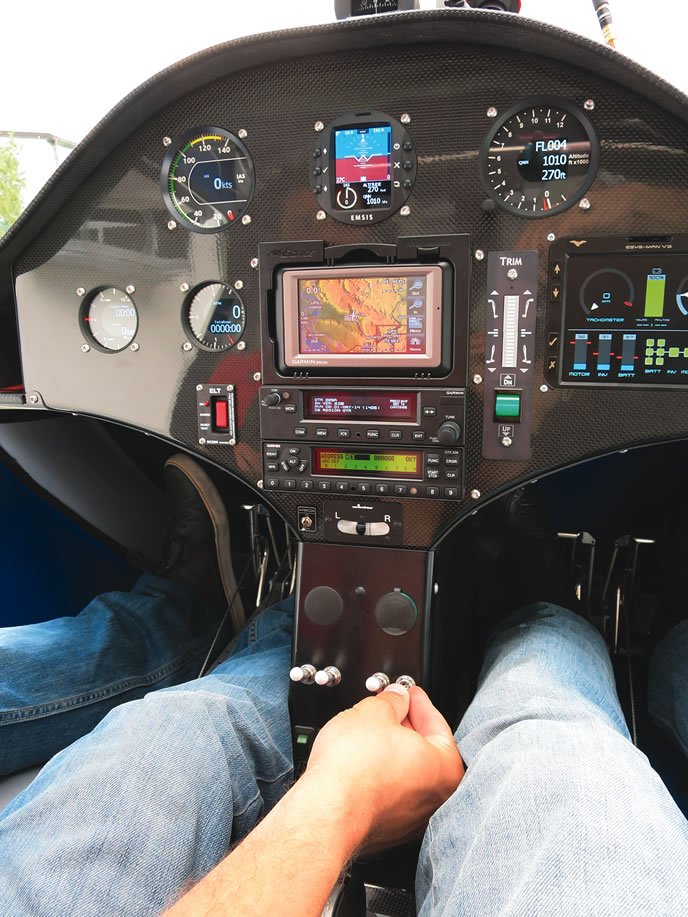
Lithium-ion battery fires occur for two principle reasons: Cell shorts and unbalanced charging between cells, with the latter the more common. To keep cells balanced and produce the highest capacity battery packs, Pipistrel sorts the individual cells according to measured capacity and rejects as many as 5 to 7 percent as outliers because each cell array is balanced to the lowest output cell. This yields more efficient battery arrays that the battery management system can easily balance.
Pipistrel developed its own smart charger for the aircraft which plugs into a socket on the bottom of the fuselage. The charger senses the required charging voltage and will automatically halt charging if it detects significant imbalance between the logical cells. It’s not capable of isolating individual imbalanced cells. In the aircraft, voltage is delivered from the two battery packs through two separate contactors. When the cockpit battery switch is activated to close the contactors, there’s a noticeable delay as current is routed through a resistor to allow the system to correct minor imbalances. If the imbalance is too great—theoretically unlikely because the packs are charged together—the airplane’s computer won’t allow a power up. In other words, although the airplane’s system monitor is capable of displaying all this, it’s transparent to the pilot.
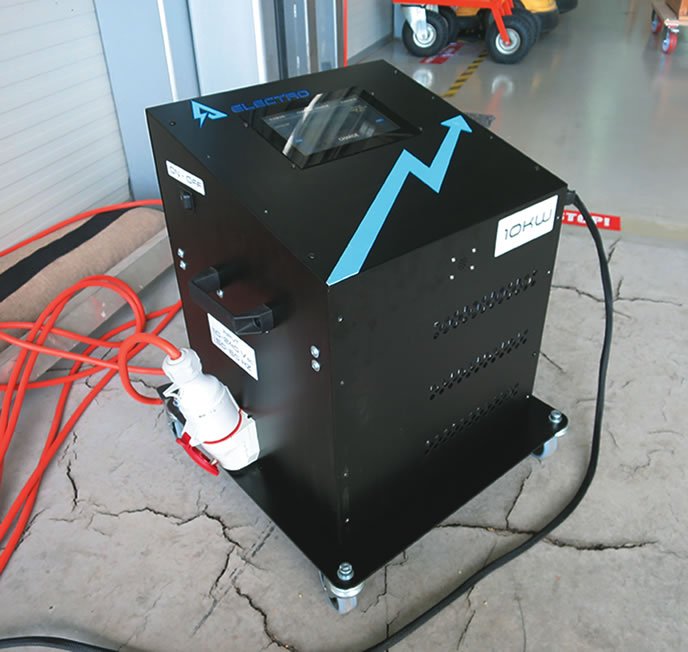
Charging should take two hours, but more or less depending on available electrical service. Three-phase power, which commercial hangars often have, results in faster charging. Pipistrel’s marketing idea is to sell a school two Electros with one spare battery set between them, allowing charging while the aircraft are flying.
Flying It
We took two brief flights in the Electro, both with fully charged batteries. Pipistrel’s Nejc Faganelj did the demo flying. Preflight consists of familiar airframe checks, plus checking the charge and health level of the batteries. Each individual battery box contains its own monitor similar to the Paperwhite display Amazon uses for Kindles. Battery charge state and health state are annunciated, along with internal temperature. In lithium-ion batteries, health state refers to loss of cell capacity with aging—a measure of actual battery energy capacity compared to what they could hold when new.
By intention, the Electro panel looks the same as the gasoline Alpha does—same instruments and arrangements. But in place of an engine monitor, the Electro has a battery system monitor that minds total battery capacity, motor, inverter and battery temperatures, RPM and a separate battery powering the avionics. The avionics battery charges from the main system batteries, as necessary.
Four switches at the bottom of the pedestal activate the aircraft systems with the right most switch a power enabler to conncect the batteries to the motor. The switch circuit has an electronic throttle-position sensor that won’t allow the motor to become active unless the throttle starts at zero. There’s really no run-up; just a final check of trim and battery capacity. Interestingly, when the airplane is lit up, there’s a noticeable buzz that sounds just like a priming pump. It’s the coolant pump for the electric motor.
Once the throttle is advanced, the airplane flies likes its gasoline counterpart with similar acceleration and climb. No surprise there, since it has the same power. What is surprising is the noise. There’s no silent whoosh of clean electric power, but a noise level similar to the gasoline version, with slight prop-tip noise and pulsing against the windshield from the prop slipstream. From outside the airplane, however, the Electro is downright stealthy. After our pattern flights, Faganelj flew a series of low-altitude, high-power flybys. The airplane isn’t quite silent, but its noise is barely discernible until it’s quite close or has flown past.
Although the Electro is supposed to be flown no differently than the gasoline version, there may be slight variation in technique. Because it has plenty of power and low drag, Faganelj reduced power after takeoff from a high of 77 kWh indicated to about 60 kWh. (The same technique is recommended in the gasoline Alpha.) In the downwind, power is further reduced to about 40 kWh for an indicated speed of about 70 knots.
The Electro is designed to recuperate energy in the glide so on final, power is reduced to idle and, indeed, the power indicator showed the system returning charge to the batteries in the 3- to 5-kWh range. The airplane has a purpose-designed prop for this, which is much broader of chord for the first third of blade length outward from the hub. Pipistrel calls this a “propmill.” Whether adjusting the length and steepness of the final glide makes much meaningful difference in endurance for the Electro’s primary mission is debatable. But there’s no question that the prop provides noticeable drag. With zero torque selected via the throttle, braking from the prop when the pitch is pushed over is quite noticeable.
Recuperation or not, our first flight lasted 20 minutes and included some flight outside the pattern. We landed with 51 percent capacity remaining. Duration of the second flight, including flybys, was 38 minutes, with 25 percent battery capacity remaining. Prior to the flybys, we did 10 touch and goes, which might be a typical lesson for a student using this airplane for its stated purpose. We estimate the Electro could have completed 15 or 16 landings with sufficient reserve for landing and taxi back.
A Start
The Alpha Electro is, if nothing else, an impressive technical foray into the possibilities and limitations of electric flight. Given its limited endurance, we agree that it’s a niche product for early adopters and then only in Europe and Asia. U.S. certification rules still preclude electric aircraft for other than experimental purposes.
As Ivo Boscarol told us, companies pioneering electric flight can’t reach for off-the-shelf hardware to execute their designs. Everything has to be invented and developed on the fly for a market that’s limited. Despite its short endurance, the Electro is capable of its narrow mission of teaching landings and takeoffs, with sufficient reserve for safe operation.
Although we can’t predict how the market will warm to new electric airplanes, if electric flight is to sustain, the Electro clearly represents a first necessary step toward getting there.


